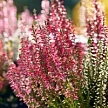
Calluna
Large bright beams
| Latin name | Calluna |
| Homeland | Europe |
| Family | Ericaceae |
| Cultivation | not very easy |
| Location | in the open sun |
| Temperature | resistant to both low and high temperature |
| Watering | regular spring-summer |
| Flowering time | late summer - autumn |
| Height | 30-70 cm, rarely up to 1 m, depending on the species |
| Transplanting | at the end of winter |
| Appearance maintenance | remove faded shoots |
The genus Heather consists of a single species - the common heather (Calluna vulgaris), a perennial resistant plant that is often mistakenly attributed to the genus Erica. He loves sandy soils in nature, grows strongly in clearings and forms continuous thickets, is found in peat bogs. It is a low (30-70 cm high) evergreen shrub with small sessile, closely spaced sharp-scaly leaves. In late summer - autumn, numerous straight brushes of small purple, on short pedicels, simple or double flowers appear. Among the numerous forms and varieties there is heather with white flowers (White), pink (Alexandra and Dark Star), crimson-pink (Anne Marie and Beta Elizabeth). Decorativeness is given to the plant by the color of its leaves, the general shape and appearance. In erect and creeping cultivars, in the warm season, the leaves are silvery-gray, bright orange, red, yellow or with color transitions from light green to dark green, and in winter the leaves turn red.
The genus Heather consists of a single species - the common heather (Calluna vulgaris), a perennial resistant plant that is often mistakenly attributed to the genus Erica. He loves sandy soils in nature, grows strongly in clearings and forms continuous thickets, is found in peat bogs. It is a low (30-70 cm high) evergreen shrub with small sessile, closely spaced sharp-scaly leaves. In late summer - autumn, numerous straight brushes of small purple, on short pedicels, simple or double flowers appear. Among the numerous forms and varieties there is heather with white flowers (White), pink (Alexandra and Dark Star), crimson-pink (Anne Marie and Beta Elizabeth). Decorativeness is given to the plant by the color of its leaves, the general shape and appearance. In erect and creeping cultivars, in the warm season, the leaves are silvery-gray, bright orange, red, yellow or with color transitions from light green to dark green, and in winter the leaves turn red.
Cultivation
Heather is used for landscaping, grown in open ground for the arrangement of borders and flower beds, as well as cut flowers (the highest forms), in addition, in pots on balconies and terraces. This plant requires an acidic, preferably peaty soil, it does not tolerate liming. If the pH value is above 5, then add acidic white peat. When grown outdoors, plants are planted permanently in fall or spring. When planting plants in borders, a distance of 30-40 cm or more is left between them, depending on their intended size. To fill the pots, a mixture of peat and sand or agroperlite is used, filled with complex fertilizer at the rate of 20 g per bucket of soil. During the spring-summer period, once every 15-20 days, fertilizers for acidophilic plants acidifying the soil are diluted in water for irrigation at the rate of 15 g per bucket.
Heather is used for landscaping, grown in open ground for the arrangement of borders and flower beds, as well as cut flowers (the highest forms), in addition, in pots on balconies and terraces. This plant requires an acidic, preferably peaty soil, it does not tolerate liming. If the pH value is above 5, then add acidic white peat. When grown outdoors, plants are planted permanently in fall or spring. When planting plants in borders, a distance of 30-40 cm or more is left between them, depending on their intended size. To fill the pots, a mixture of peat and sand or agroperlite is used, filled with complex fertilizer at the rate of 20 g per bucket of soil.
During the spring-summer period, once every 15-20 days, fertilizers for acidophilic plants acidifying the soil are diluted in water for irrigation at the rate of 15 g per bucket.
Location
Heather prefers a place in the open sun.
Temperature
Heather is a plant that is resistant to fluctuations in air temperature.
Watering
Water regularly, especially during the spring and summer period, so that the ground is moist all the time.
Transplant
They are transplanted annually at the end of winter into a new pot slightly larger than the previous one.
Care
Remove faded and damaged parts.
Reproduction
Propagated by seeds and cuttings. In the summer, cuttings 3-4 cm long are taken from the branches on which there were no flowers, they are treated with growth stimulants and planted in a mixture of sand and peat (or peat and agroperlite), kept in a heated room at a temperature of 20 ° C. Rooting occurs fairly quickly (after 25-40 days).
Diseases
Heather affects oidium (grape powdery mildew), a whitish fluffy bloom forms on the leaves and shoots. They get rid of it with the help of drugs specially designed to combat powdery mildew. The mottling, which can be caused by fungi of the genus Phytophthora, destroys leaves and shoots. This disease is fought by treating the bushes with fungicides.
Acquisition
Heather is easy to find in nurseries. Select compact, lush bushes in the budding phase, checking their condition.